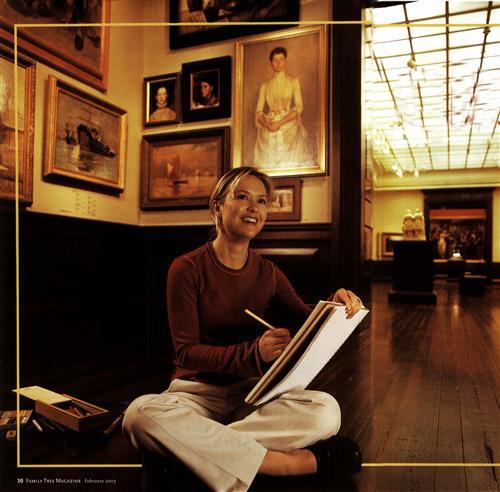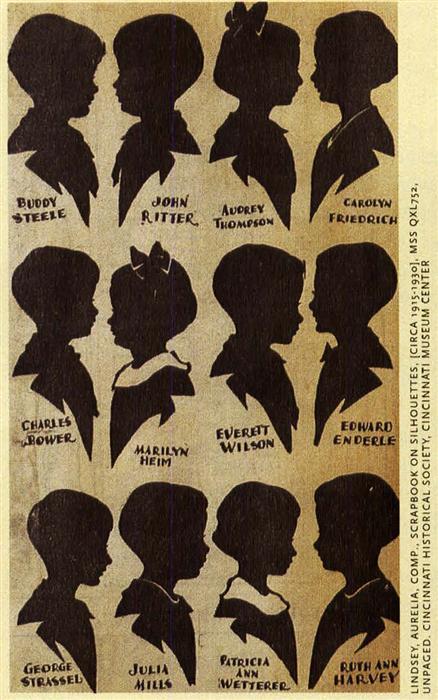Rumor among your relatives is that the family nose (which you unfortunately inherited) descends from Great-great-great-uncle Harry. You’d love to find a picture to see if he’s really responsible for this facial feature, but Harry died before the advent of photography in 1839. Don’t give up! Just because you don’t have a photograph of Harry doesn’t mean that you can’t discover other visual evidence of this family trait, or other glimpses of your earlier ancestors.
When Louis Daguerre invented the daguerreotype, the first type of photographic image, he was just one of many individuals looking for a new way to capture a realistic likeness of people and places. For centuries, professional and amateur artists had employed a variety of techniques to memorialize a person, from paintings to engravings. Americans loved to have their likenesses captured by itinerant artists, who frequently painted their subjects’ heads on top of pre-painted portraits. In C.B. King’s circa-1815 painting Itinerant Painter, the whole family watches while the mother of a typical family has her picture painted. Sitting for a silhouette was also a popular form of entertainment.
You can uncover written accounts of what an ancestor looked like. In fact, Colonial Americans used a standard descriptive vocabulary when posting advertisements in local newspapers to enable citizens to spot and apprehend criminals as well as runaway slaves and servants.
Whether you’re looking for the genetic origins of family traits or to fill in the blanks in an illustrated family tree or scrapbook, a little detective work can often turn up clues from before the creation of the camera. Sometimes you’ll hit a dead end. But sometimes the places to seek ancestral images are as plain as, well, the nose on your face. Here are some ideas to get started:
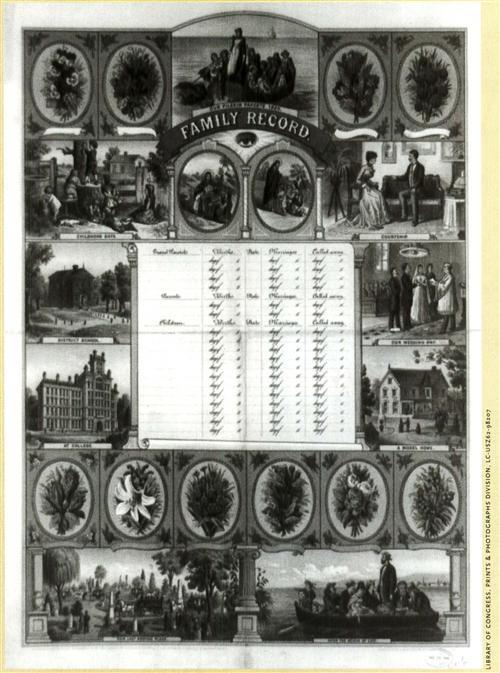
Before the dawn of photography, artistically inclined family members created illustrated family records with genealogical information that sometimes included watercolor portraits or pen-and-ink drawings. D. Brenton Simons mentions several examples in his essay “New England Family Record Broadsides and Portraiture, and the Letterpress Artist of Connecticut” in The Art of Family: Genealogical Artifacts in New England (New England Historic Genealogical Society). For instance, in 1837, 21-year-old Carolyn Hill of New Hampshire created a pen-and-ink drawing of her family with genealogical information shown as a framed artwork behind the group. Simons cites another artist who chose to paint individual watercolor portraits on a single sheet of paper with the subjects’ birth dates underneath. Genealogists often overlook both the genealogical information and visual documentation in these artistic family records. Of course, the quality of the portraits depended on the skill of the artist, but wouldn’t it be wonderful to find a picture of Uncle Harry drawn by one of his children?
Silhouettes
These black-paper shadow portraits, profiles or shades appeared in the mid-18th century. Individuals would sit before a lamp casting a shadow on a wall. The shadow could be traced, and the resulting design was cut from a single sheet of paper. The silhouettes were commonly framed with the person’s name written beneath the likeness. In the late 18th century, silhouettes became quite popular because of the belief that you could tell a person’s character from his or her facial features and shape of the head. Wonder what Harry’s nose said about him!
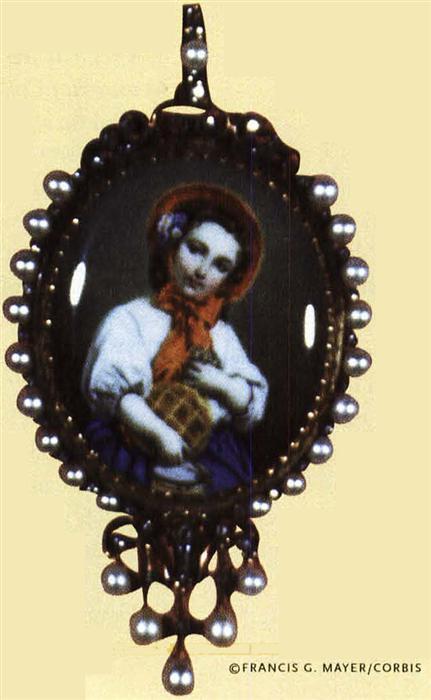
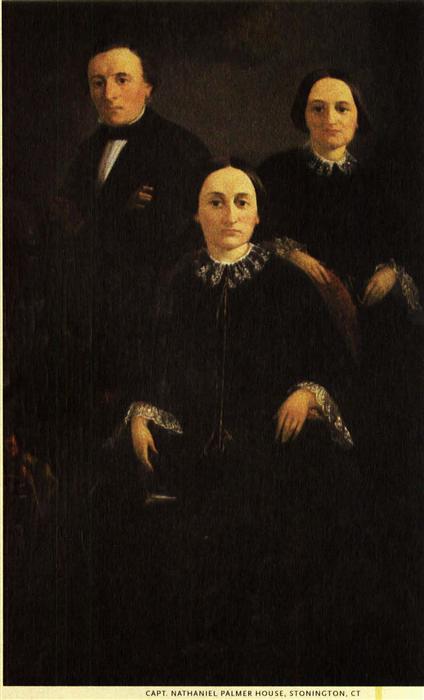
Paintings
In the mid-14th century, Emperor Charles IV of Prague commissioned a series of portraits of 60 ancestors and relatives. Unfortunately for royal genealogists, many of the portraits are not of real people but of mythical figures — so Charles’ family portrait album looked a little different from yours. Even if you don’t have imperial lineage, a few rare collections of ancestral portraits have been passed from parents to their children. Most painted portraits end up in museums or simply lost.
Commissioned portraits were for the wealthy or artists and their families. Early on, sitting for a portrait was unpopular, deemed unseemly and vain. Some individuals, such as Thomas Whythorne, decided to have a portrait painted anyway. Whythorne commissioned one about 1549 and another a year later to assess his own aging. In the 1763 French novel Le Noble Satire, the heroine throws family portraits out a window to break her fall. The author quips: “She had never believed she could get such support from one’s ancestors.” As genealogists, you know the value of a family portrait is its informational content, not in its durability!
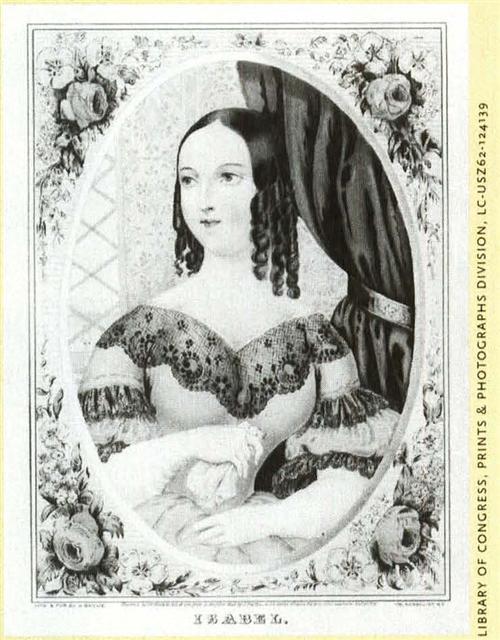
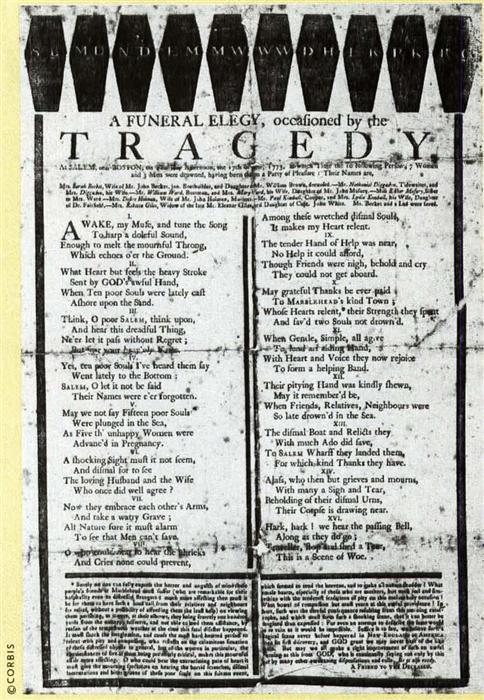
Written descriptions
In 18th-century America, newspapers and posters (“broadsides”) helped inform residents of happenings in their area and the world. The typical newspaper was just four pages long, with the back page dedicated to advertisements, some of a personal nature. You might find a description of your ancestor in a newspaper or broadside. For instance, relatives of one Benjamin Cleveland might be dismayed to discover a Revolutionary War deserter in their family but delighted to know that in 1776 he was “19 years old, 5 feet 4 inches high, light complexion, red hair, light eyes, born in Newport, RI” and was a mariner. Such printed descriptions relied on a commonly understood vocabulary — sort of the verbal equivalent of a police sketch artist. For example, “scarified” indicated the person had significant scars. A person’s complexion was often described as “light, dark, swarthy or ruddy.” Personality traits were even mentioned — “an artful, talkative pert fellow.”
Uncovering old images
So where can you search to find these pre-photographic portraits and other clues to how your ancestors looked? You’ll discover plenty of options. It’s a rare book, for example, that doesn’t contain at least one picture. Either the author supplies those images or a professional picture researcher is hired to find appropriate images. Learn to follow their steps to locate images of your ancestors before the age of photography.
The first step in all picture research is a visit to a large research facility — in person at a museum, public or university library or historical society, or virtually via the Internet. Most large museums have libraries, and many offer research hours to the public. You can use their facilities to search card catalogs and specialized art indexes, and to look through art-specific journals. Major public libraries such as the Boston Public Library <www.bpl.org> and the Allen County Public Library in Fort Wayne, Ind., <www.acpl.lib.in.us> offer patrons a separate department with reference materials to help with art searches. And don’t forget to check local historical societies and libraries in the areas your ancestors lived. Most have local history collections that include picture files.
You can also search manuscript finding aids such as the National Union Catalog of Manuscript Collections (NUCMC) (portions are online at <lcweb.loc.gov/coll/nucmc/nucmc.html>) to locate illustrated family records, letters and diaries. NUCMC can help find documents that list physical descriptions, such as pension applications, as well.
At your library, the best printed index to portraits is a four-volume set published by the Library of Congress, the ALA Portrait Index: Index To Portraits Contained in Printed Books and Periodicals. While it has never been updated, you can find this classic reference source in most libraries. It should be your first stop when looking for portraits painted or printed before 1906. Also check Print Index: A Guide to Reproductions, compiled by Pamela Jeffcott Parry and Kathe Chipman, which covers prints from the mid-18th century. Your library’s reference shelf also probably has Art Index, an annual index to art periodicals published from 1929 to 1991. You can also search a variety of periodicals using Online Computer Library Center’s First-Search, a reference tool available at major libraries and research institutions.
Online, you can search the Catalog of American Portraits at the National Portrait Gallery <www.npg.si.edu/sea>. This catalog contains data on more than 100,000 portraits — paintings, sculptures, drawings, miniatures and silhouettes.
Unfortunately, there is no index to illustrations that appear in published genealogies, but the family histories themselves are easy to find with a list of surnames and accessibility to a major genealogical collection in your area. While genealogies didn’t regularly include portraits until the mid- to late 19th century, you might find some earlier prints illustrating more recent publications. Check the frontispiece of each genealogy that relates to your family name to see if illustrations were used. Online catalog listings also may note whether books have illustrations; see <www.familytreemagazine.com/articles/librarylinks.html> for links to some leading libraries’ virtual card catalogs.
To hunt for ancestral descriptions in early newspapers, you can tap online newspaper databases such as Accessible Archives (<www.accessible.com>, $59.95 a year or $19.95 for 30 days) or Ancestry’s Historical Newspaper Collection (<www.ancestry.com/search/rectype/periodicals/news/main. htm?lfl=ttd>, $79.95 a year or $29.95 for three months). For microfilmed archives of local newspapers, the United States Newspaper Project <www.neh.fed.us/projects/usnp.html> is a good starting place. You can also check newspaper abstracts, such as those published by Picton Press <www.pictonpress.com>.
As you search these sources, don’t stop at the invention of the daguerreotype in 1839. Of course, photography didn’t completely displace older techniques of capturing likenesses. Our ancestors continued to sit for portraits, create family records and have engravings made long after photographs became popular. So try these same methods to locate images of your more recent ancestors who may have been camera shy.
And don’t focus on just the people in your family tree. Be on the lookout for depictions of the towns they lived in, examples of occupational dress, places they attended school, maps drawn at the time they lived and other visuals. These sources let you picture your ancestors’ world as it was before cameras could record it.
For example, while no pictures exist of Christopher Avery, who immigrated to Gloucester, Mass., in the 17th century and worked as a weaver, you can find descriptions in contemporary diaries of what a typical weaver wore and at least one engraving of such an outfit. Likewise, no portraits were painted of Avery’s prominent son James, but you could uncover countless depictions of the family homestead known as the Hive.
From the February 2003 issue of Family Tree Magazine.

